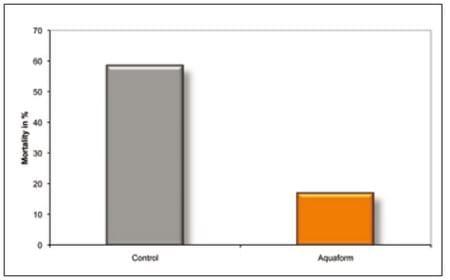Potassium Diformate in tilapia nutrition
Utilization of acidifiers in tilapia nutrition and feeding
Published: June 16, 2011
By: Christian Lückstädt (Addcon)
A short review on the use of potassium-diformate
Routine use of antibiotics as growth promoters is a matter of debate in the animal farming industry. The use of low levels of these antibiotics in animal feeds possesses the possibility to transfer bacterial immunity to species pathogenic in animals and humans (Liem 2004). The EU has banned all antibiotic growth promoters (AGP) from livestock production with effect of January 2006. Public opinion and regulation authorities in most of the export countries focusing now on the misuse of antibiotics in aquaculture and public attention have shifted towards production methods. Therefore, alternatives to AGP are worldwide sought in a variety of forms. Acidifiers consisting of organic acids and their salts present a promising alternative and they have received much attention as a potential replacement in order to improve the performance and the health of treated animals. In animal nutrition, acidifiers exert their effects on performance via three different ways (Freitag 2007): (a) in the feed; (b) in the gastro-intestinal tract of the animal; and (c) due to effects on the animal‘s metabolism.
The beneficial effects of acid preserved products caught the attention of the scientific community to investigate the effects of these short-chain acids onto the fish feed directly. In recent years the use of acidifiers in fish nutrition got more popular (see the review paper - Lückstädt 2008). Several studies have been especially conducted with potassium-diformate (a double-salt of formic acid) in herbivorous filter feeders like tilapia.
Ramli et al. (2005) tested potassium diformate (potassium salt of formic acid) as a growth promoter in tilapia grow-out in Indonesia (Table 1). In this study, fish were fed over a period of 85 days 6 times a day diets containing different concentrations of potassium diformate (0%, 0.2%, 0.3% and 0.5%). The diets contained 32% crude protein, 25% carbohydrates, 6% lipids and 10% fibre. The fish were challenged orally starting day 10 of the culture period with Vibrio anguillarum at 105 CFU per day over a period of 20 days.

Table 1: Effects of potassium diformate supplementation in diets on performance of tilapia challenged with V.anguillarum (modified from Ramli et al. 2005)
Over the entire feeding period from day 1 to 85, potassium diformate significantly increased feed intake (P< 0.01) and weight gain (P< 0.01) as well as improved the feed conversion ratio significantly (P< 0.01). Furthermore, protein efficiency ratio was also significantly improved due to the addition of the formic acid salt (P< 0.05). The improvement was best with 0.2% and 0.5% addition of the formate. Survival rates of fish after the challenge with V. anguillarum on day 10 were also significantly higher compared to the negative control and the effect was dose dependent (P< 0.01). The authors concluded that the application of potassium diformate at 0.2% is an efficient tool to control bacterial infections in tropical tilapia culture.
Similar results were achieved by Zhou et al. (2008), who tested hybrid tilapia (Oreochromis niloticus x Oreochromis aureus) fingerlings (2.7 g initial weight) in a dose response study with potassium diformate (0%, 0.3%, 0.6%, 0.9% and 1.2%), while also comparing the results with an antibiotic growth promoter (8 mg / kg Flavomycin). During the 56 day trial period, tilapia fed all the potassium diformate enriched diets grew faster than the negative control (an increase of up to 11.6%), while fish fed 0.3% and 0.6% potassium diformate achieved even better weight gain than the fish in the positive control group. The authors speculated that dietary potassium diformate could stimulate a beneficial bacterial colonization of the intestine.
The latest study with this highly effective substance was carried out in Malaysia (Ng et al. 2009). There, a 14-week feeding trial was conducted to determine the effect of dietary organic acids. The experimental diet was added with 0.2% of potassium diformate and fed to triplicate groups of red hybrid tilapia. Upon completion, tilapias were challenged with Streptococcus agalactiae. Results clearly showed that total bacteria per gram of faeces were significantly reduced in diets containing potassium diformate. The number of adherent gut bacteria tended to be lower as well. Furthermore, apparent digestibility of phosphorous was improved too - by nearly 11% in acidified diets. Finally, cumulative mortality of fish fed no organic acids (58.3%) was higher compared with fish fed the potassium diformate supplemented diet (16.6%) at 16 days post challenge (Figure 1). The Malaysian data showed that the inclusion of this acidifier can exert strong antimicrobial effects and have the potential to exert beneficial effects on nutrient utilization as well as disease resistance in tilapia. Organic acid salt may be therefore especially during the grow-out period of high importance for tilapia culture (Lückstädt 2008).

Fig. 1: Mortality in tilapia post challenge with Streptococcus agalactiae fed with or without Aquaform (potassium diformate)

Conclusiones
Results from the aforementioned studies indicate promising potential and compel aqua feed manufacturers to consider using acidifiers in their diets. The use of acidifiers, especially of potassium diformate in tilapia, will be an efficient tool to achieve sustainable, economical, and safe fish production.
Related topics:
Authors:
ADDCON
Recommend
Comment
Share
ADDCON
1 de agosto de 2011
Dear Mr. Emmanuel,
effects on tropical catfish will not differ significantly form the effects achieved in tilapia. All those fish have a monogastric digestive system and have therefore a similar digestion. Current studies in Asian catfish (Pangasius) in Vietnam showed strong effects of potassium diformate on weight gain as well on improved FCR and survival rates, thus showing an overall improved fish productivity under commercial circumstances. As of now we are also testing the product in African catfish. Let us know your contact details and we can send you an update once that trial has been finished.
Recommend
Reply
Aquapro Agro Industry
25 de julio de 2011
This is good eye opener but i would like to know the effect on tropical catfish. If i can get in nigeria i will to use it on commercial catfish. Would you tell me how to get aquaforms in nigeria?
Recommend
Reply

Would you like to discuss another topic? Create a new post to engage with experts in the community.





.jpg&w=3840&q=75)